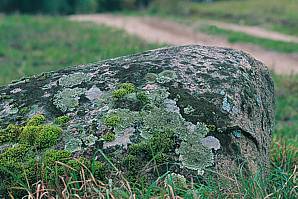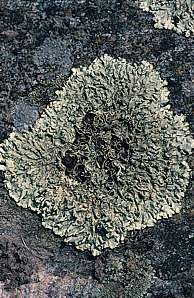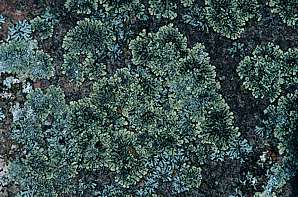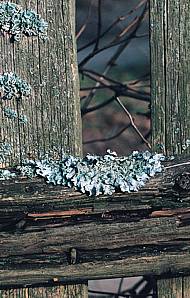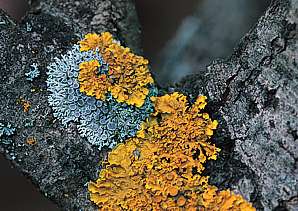|
LICHENS
|
||||||||||||
Text:
|
The lichens growing on the rocky substrates and the multi-habitat lichens
THE LICHEN GROWING ON THE ROCKY SUBSTRATES (epilithic) are met on the rocks, both of natural (stones, rocks, erratic stones) and anthropogenic (concrete buildings, plaster, tiles) origin; they form groups, consisting mainly of pioneer species. The composition of the group is determined by the chemism of the substrate where lichens grow, e.g. Neofuscelia loxodes prefers the silicate rocks, Lecanora albescens prefers the calcareous rocks and Lecidea fuscoatra prefers the silicate rocks and sandstones.
Porpidia crustulata has a very thin, shell-like grey or white thallus. Numerous sporophores are arranged in a regular or scattered manner. It grows on the silicate rocks, sandstones and pebbles in the forest and in the open space.
Lecanora polytropa has a very variable grey, white or green thallus which can be shell-like, nipple-like or seed-like. It mainly grows in light places such as the silicate rocky substrate, the erratic stones, pebbles etc.
Xanthoparmelia conspersa has a leafy close-fitting to the substrate thallus in the shape of rosette which is yellow or grey and green becoming more dark in central parts. It grows on the silicate rocks and in open space.
Lecanora dispersa is a white or grey and white lichen with shell-like, seed-like or floury thallus. It grows on the calcareous substrates (concrete, cement) in open space; it rarely grows on the silicate rocks. It is one of the lichen starting to grow on the artificial rocky substrates.
Rhizocarpon obscuratum has a shell-like thallus consisting of dense grey, dark grey or tawny areoles (these are fragments of thallus which cracked as the consequence of growing) which have got a flat, convex or cloddish surface. It grows on the silicate rocks.
Candelariella coralliza has a shell-like thallus forming pillow-like cracked yellow or green and yellow areoles with seed-like surface. It grows on the silicate rocks and other areas lacking calcium.
Acarospora fuscata has a grey and brown or yellow and brown glittering thallus in the shape of shells, areoles or hulls. It grows on the silicate rocks.
THE MULTI-HABITAT LICHENS (ubiquitstic) are the lichen to be met on a very different substrates. Such lichen grow well both on the rocky substrates (e.g. walls and erratic stones), on the trees, on the deadwood and on the ground, too.
Lecanora muralis has a leafy thallus on the edges, shell-like in the central parts and usually covered with the numerous sporophores. It is grey and green and the bottom side is white. It can be commonly found on the calcareous rocks and rocks lacking the calcium, on the barks of trees and on the wood.
Hypogymnia physodes has a leafy thallus which is strongly divided into sections of different widths. This thallus is grey, grey and green or even brown especially in the places exposed directly to sun. The convex sections are loosely attached to the substrate with the help of rhizines of the bottom cortex. The bottom side of the cortex is black and the edges, without the rhizines, are brown. It commonly grows on a very different substrates and in many places, e.g. on the bark of trees, twigs of shrubs and bushes, on the rotting wood and on the rocks, in forests and in non-forest communities. It prefers moderately or strongly acid substrates.
Parmelia saxatilis has a glittering blue, grey or brown on the edges leafy and rosette-like thallus. The bottom side of cortex is black with numerous black rhizines. It grows on the silicate rocks and on the bark of trees.
Candelariella aurella has a yellow, yellow and green or yellow and grey thallus in the form of small seeds which are compact or scattered. It grows on the calcareous substrates; it rarely grows on the silicate substrates or on the bark of trees and the wood.
Parmelia sulcata has a grey, green or blue and grey leafy thallus in the shape of rosette. The bottom side of the cortex is black with numerous black rhizines. It grows on the bark of trees, the wood, on the rocks lacking calcium, sands and dunes.
Physcia adscendens has a grey leafy thallus in the shape of short sections which are widened at the ends and which have numerous long cilia on the banks. The bottom side of the cortex is white with small rhizines. It grows on the bark of leafy trees, on the concrete in a well-lit places, on the calcareous rocks and the rotting wood. It is a common lichen which is resistant to any pollution.
Xanthoria parietina has got a green or orange and yellow thallus in the form of rosette whose upper surface is smooth or wrinkled, without the nipples and blisters. The bottom side is white and it usually does not have any rhizines. It grows on the bark of trees, on the rocks, concrete and on the rotting wood.
Lepraria incana has different kinds of thallus: shell-like, powder-like, web-like or seed-like. The coloration can be grey and green, blue and white and green or sometimes white. It belongs to the so-called imperfect lichen - as it does not produce sporophores. It grows on the bark of trees and shrubs, bryophytes and on the wood. It rarely grows on the rocky substrates and soil. It is extremely resistant to air pollution.
|
|||||||||||
|
|
|
